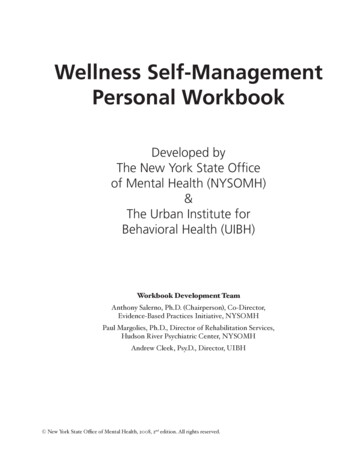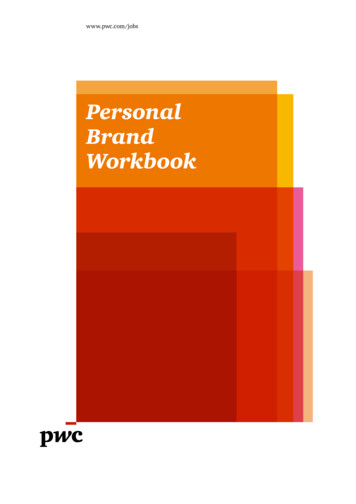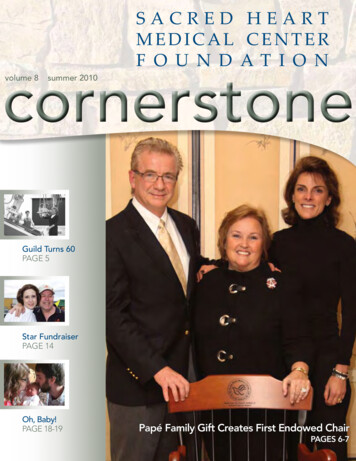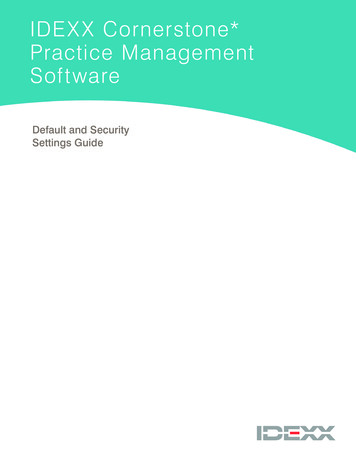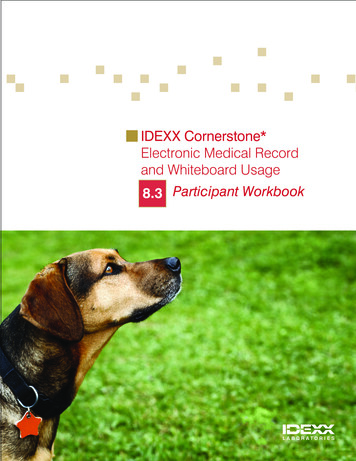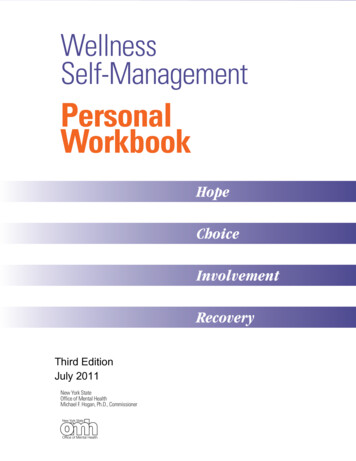
Transcription
nvolvementRecoveryThird EditionJuly 2011New York StateOffice of Mental HealthMichael F. Hogan, Ph.D., Commissioner
Rr
Personal Workbook Wellness Self-ManagementPersonal WorkbookDeveloped byThe New York State Officeof Mental Health (NYSOMH)The Urban Institute forBehavioral Health (UIBH)Center for Practice InnovationsSM (CPI)New York State Psychiatric InstituteWorkbook Development TeamAnthony Salerno, Ph.D. (Chairperson),Evidence-Based PracticesNew York State Office of Mental HealthPaul Margolies, Ph.D., Associate Directorfor Practice Innovation and Implementation,Center for Practice InnovationsNew York State Psychiatric InstituteAndrew Cleek, Psy.D., Director,Urban Institute for Behavioral Health New York State Office of Mental Health, 2010, 3rd Edition. All rights reserved.1
2 Wellness Self-ManagementACKNOWLEDGEMENTSThe development and support for the widespreadimplementation of the Wellness Self-Management(WSM) program was made possible by the activeleadership of Michael F. Hogan, Ph.D, Commissioner of the New York State Office of Mental Health.Special appreciation is extended to Robert Myers,Ph.D., Associate Commissioner for Adult Servicesfor his highly visible, direct and continuous supportof the WSM and related initatives throughout NewYork State.Furthermore, the Center for Practice Innovations atNew York State Psychiatric Institute, under the direction of Susan Essock, Ph.D., has been instrumental in providing the necessary technical and evaluation resources and expertise to insure successful development, implementation and evaluation of boththe Adult WSM and KEY initatives in NYS.Appreciation is extended to Sharon Carpinello,Ph.D, former Commissioner of the NYSOMHwhose leadership was the catalyst for the development of the WSM program.Appreciation is also extended to the following individuals for their contributions:Peter Beitchman, D.S.W., Executive Director,The Bridge, Inc.Peter C. Campanelli, Psy.D., President & CEO,The Institute for Community Living, Inc. (ICL)Cathy Cave, L.C.S.W., Director of Cultural Competence, NYSOMHAmy Colesante, Office of Recipient Affairs, NYSOMHRosa M. Gil, D.S.W., President & CEO, Comuni life, Inc.Sharon Gold, L.C.S.W., Director of ContinuingDay Treatment, The Bridge, Inc.Chris Keane, F.N.P., ICLHarvey Lieberman, Ph.D., Consultant to ICLBenjamin R. Sher, M.A., L.M.S.W., Director ofTraining, ICLTony Trahan, Office of Recipient Affairs, NYSOMHCaren Weingart, L.C.S.W., Clinical Supervisor,The Postgraduate Center for Mental HealthSheetal Rayancha, UIBH Administrative AssistantThe initial version of the WSM workbook was piloted at ten agencies affiliated with UIBH and atHudson River Psychiatric Center in Poughkeepsie,New York. The Workbook has been shaped by feedback provided by the consumers, staff and leadersof these organizations. Without their efforts, theWorkbook could not have been developed.The Workbook includes material that has been reprinted or modified with permission from:OMH Office of Recipient Affairs. (2005). Recommendations: Infusing Recovery Principles inthe Illness Management & Recovery ResourceToolkit. Albany: New York State Office of MentalHealthRyan, S.W., Littrell, K.H., Sowers, C., & Peabody,D.D. (2003). Solutions for Wellness (2nd ed.) ( EliLilly and Company). Available at www.treatmentteam.comWeiden, P.J., Scheifler, P.L., Johnson McCrary, K.et al. (2003). Team Solutions (3rd ed). ( Eli Lillyand Company). Available at www.treatmentteam.comThis Workbook also includes material reprinted ormodified from sources in the public domain. Theseinclude:Mueser, K., and Gingerich, S. (2003). IllnessManagement & Recovery Implementation ResourceKit. Washington, DC: United States Department of Health and Human Services, SubstanceAbuse and Mental Health Services Administration. Available at illness/02.IMR Users.pdf
Personal WorkbookOnken, S., and Dumont, J. (2002). Mental HealthRecovery: What Helps and What Hinders? A NationalResearch Project for the Development of Recovery Facilitating System Performance Indicators.Alexandria, VA: National Technical AssistanceCenter for State Mental Health Planning.The Workbook represents an adaptation of existing open-source reports and educational materials,as well as considerable new material created by theWorkbook Development Team. Adaptations generally involved changes in language, format, sequencing of topics and organization of lessons. Furthermore, the Workbook was designed to reflect theprinciples of recovery, recognize the role of culturaland religious values, highlight the connection between mental and physical health and address thechallenges of providing WSM services in a groupmodality.Most notably, we are indebted to the work of KimMueser, Ph.D., and Susan Gingerich, M.S.W., whodeveloped the comprehensive Illness Managementand Recovery (IMR) practice and related resourcekit. The WSM Workbook incorporates many of thetopic areas from the IMR resource kit. In addition,the IMR emphasis on a comprehensive curriculumand key clinical practice competencies, such as motivational, educational and cognitive behavioral approaches, served as the conceptual foundation forthe WSM Workbook and related training materials. 3The Workbook development team was also influenced by the Psychiatric Rehabilitation approachdeveloped by Dr. William Anthony and colleaguesat Boston University. An adaptation of the ROPESteaching technique forms the foundation for theformat utilized in the Workbook’s lessons.We are grateful for the contributions of the participants in the Illness Management and Recovery dissemination project, which received support fromNYSOMH and the Substance Abuse and MentalHealth Services Administration and funds from theRobert Wood Johnson Foundation. Participants’work and feedback heavily influenced the development of this Workbook. Additionally, we appreciate the thoughtful and constructive feedback ofthe members of several focus groups who reviewedthese materials as they were developed.We also wish to acknowledge the contribution ofEli Lilly and Company, which developed the Solutions for Wellness and Team Solutions educationalmaterials, disseminated through the University ofMedicine and Dentistry of New Jersey. Some of thematerial was directly incorporated into the Workbook, and the development of new material wasguided by the simplicity and clarity of language ofthe Lilly material.A mental health agency or treatment program interested in providingthe WSM Program may ONLY implement the program and reproduce,reprint, or distribute the WSM Workbook with prior written approval of the New York State Office of Mental Health. Requests can be directed to the Center for Practice Innovations at Columbia Psychiatry BIA.EDUIndividuals may reproduce, reprint, or distribute the WSM Workbookunder the following conditions: personal use by adults with mental healthconcerns and their family members; academic purposes by instructorsor students involved in human service and mental health education; program planning purposes by mental health staff and administrators; andadvocacy purposes by stakeholders in the mental health system.
4 Wellness Self-Management
Personal Workbook WELCOME!Congratulations on your decision to take more control over your life!As current and former recipients of services, we know it takes a lot ofcourage and hard work to make changes. The effects of mental illnesscan make even the simplest of tasks seem very difficult and drain usof our energy and resources. However, as you will learn in the firstchapter, everyone can recover from mental illness and you are incontrol of your own recovery. You are the expert on yourself and noone can tell you what your path to recovery will look like. You willhave to decide what works for you and what doesn’t. Your Workbook isdesigned to help you with these decisions.For many of us traditional treatment has been only a part of ourrecovery. To get the most out of this program, we encourage you todevelop real, authentic relationships by listening to and learning frompeople in your group and from others; to share your experiences withyour peers; to co-lead the group; to find a buddy and to follow throughon your Action Steps. Real life happens outside of the clinic and yourAction Steps will help to make it real for you.You are about to start on an adventure. What you do now willdetermine who you will become.We wish you well on the journey,The Bureau of Recipient AffairsNew York State Office of Mental Health5
6 Wellness Self-ManagementWE WANT YOUR FEEDBACKYour feedback is very important. Your experience with the WSM program gives you aspecial insight into strengths and limits of the program. Your insight will help the authors ofthe workbook improve the materials. The authors are especially interested in knowing if andhow the program was helpful to you.Please go to the survey at the end of the workbook and consider completing and tearing itout. Please send your completed survey to the WSM workbook authors by giving it to yourgroup leader or by sending it on your own to the address listed on the survey. There is alsoa survey for your group leader to complete. To protect your privacy, please do not put youname on the survey.The New York State Office of Mental HealthCenter for Practice Innovations at Columbia Psychiatry
Personal Workbook 7WELLNESS SELF-MANAGEMENT (WSM)PERSONAL WORKBOOKTable of ContentsIntroductionTopic 1: What Is Wellness Self-Management (WSM) and How Can It Be Helpful to You?Lesson 01 Wellness Self-Management Program Overview. . . . . . . . . . . . . . . . . . . 8Lesson 02 WSM: Important Points . . . . . . . . . . . . . . . . . . . . . . . . . . . . . . . 11Topic 2: Getting the Most Out of the WSM ProgramLesson 03 What Is Your Role in the Program?. . . . . . . . . . . . . . . . . . . . . . . . . 14Lesson 04 Understanding Positive and Negative Thinking . . . . . . . . . . . . . . . . . . . 17Lesson 05 Getting to Know Each Other. . . . . . . . . . . . . . . . . . . . . . . . . . . . 20Chapter 1: RecoveryTopic 1: What Is Recovery?Lesson 06 Visions of Recovery. . . . . . . . . . . . . . . . . . . . . . . . . . . . . . . . . . 22Topic 2: Setting Goals Helps RecoveryLesson 07 Exploring Your Personal Life Goals. . . . . . . . . . . . . . . . . . . . . . . . . 24Lesson 08 Understanding Barriers that Get in the Way of Achieving Goals. . . . . . . . . 27Lesson 09 Using Strategies to Overcome Barriers that Get in the Way ofAchieving Goals. . . . . . . . . . . . . . . . . . . . . . . . . . . . . . . . . . . . 30Topic 3: Understanding What Helps and What Hinders RecoveryLesson 10 What Helps Recovery? . . . . . . . . . . . . . . . . . . . . . . . . . . . . . . . . 35Lesson 11What Hinders Recovery? . . . . . . . . . . . . . . . . . . . . . . . . . . . . . . 38Lesson 12 Choosing Your Own Recovery Strategies. . . . . . . . . . . . . . . . . . . . . . 40Topic 4: Your Cultural Background and the WSM ProgramLesson 13How Your Cultural, Religious and Family Background Affects theDecisions You Make about Mental Health Treatment. . . . . . . . . . . . . . . 44Topic 5: Personal Strengths and Outside Resources Help RecoveryLesson 14 Recognizing and Using Your Personal Strengths. . . . . . . . . . . . . . . . . . 48Lesson 15Recognizing and Using Your Cultural and Community Resources . . . . . . . . 52Topic 6: Social, Cultural, and Community Supports Help RecoveryLesson 16 Social Supports Help Recovery. . . . . . . . . . . . . . . . . . . . . . . . . . . . 55Lesson 17 Using Self-Help and Peer Support . . . . . . . . . . . . . . . . . . . . . . . . . . 59Lesson 18 Connecting to Your Community . . . . . . . . . . . . . . . . . . . . . . . . . . 61Lesson 19 Meeting New People. . . . . . . . . . . . . . . . . . . . . . . . . . . . . . . . . 64Lesson 20 Getting Closer to People. . . . . . . . . . . . . . . . . . . . . . . . . . . . . . . 66
8 Wellness Self-ManagementChapter 2: Mental Health Wellnessand Relapse PreventionTopic 1: Practical Facts about Mental Health and Mental IllnessLesson 21 Introduction to Practical Facts about Mental Health and Mental Illness . . . . 69Lesson 22 Symptoms of Mental Illness—Part I. . . . . . . . . . . . . . . . . . . . . . . . . 71Lesson 23 Symptoms of Mental Illness—Part II . . . . . . . . . . . . . . . . . . . . . . . . 75Lesson 24 How Is Mental Illness Diagnosed? . . . . . . . . . . . . . . . . . . . . . . . . . 79Lesson 25 Understanding the Causes of Mental Illness. . . . . . . . . . . . . . . . . . . . 83Lesson 26 Coping with the Stigma of Having a Mental Illness Diagnosis. . . . . . . . . . 87Topic 2: Coping with Stress and SymptomsLesson 27 What Is Stress? Why Is It Important to You? . . . . . . . . . . . . . . . . . . . 91Lesson 28 Identifying Your Personal Signs of Stress. . . . . . . . . . . . . . . . . . . . . . 95Lesson 29 How to Prevent Stress in the First Place. . . . . . . . . . . . . . . . . . . . . . 98Lesson 30 Coping with Stress: What Works? What Doesn’t?. . . . . . . . . . . . . . . . . 101Lesson 31Using a Step-by-Step Formula to Improve a Problem. . . . . . . . . . . . . . . 106Lesson 32 Thoughtfully Choosing a Mental Health Problem to Work On . . . . . . . . . 109Lesson 33Choosing Strategies for Coping with Specific Problems and Symptoms. . . . . 112Lesson 34 Checking on Your Progress in the WSM Program. . . . . . . . . . . . . . . . . 120Topic 3: Making Treatment and Mental Health Services Work for YouLesson 35Choosing Types of Mental Health Services that Are Right for You . . . . . . . 123Lesson 36 Practical Facts about Medication. . . . . . . . . . . . . . . . . . . . . . . . . . 128Lesson 37 Understanding Side Effects . . . . . . . . . . . . . . . . . . . . . . . . . . . . . 132Lesson 38 Coping with Side Effects . . . . . . . . . . . . . . . . . . . . . . . . . . . . . . 135Lesson 39 Using Medication Effectively . . . . . . . . . . . . . . . . . . . . . . . . . . . . 138Lesson 40 Working Effectively with Your Doctor. . . . . . . . . . . . . . . . . . . . . . . 142Topic 4: Relapse Prevention: Developing and Using Your WellnessSelf-Management PlanLesson 41 Relapse Prevention: What Is It? Why Is It Important to You?. . . . . . . . . . 145Lesson 42 Understanding Your Personal Triggers for Relapse . . . . . . . . . . . . . . . . 148Lesson 43 Knowing Your Early Warning Signs. . . . . . . . . . . . . . . . . . . . . . . . . 150Lesson 44 Completing Your WSM Plan: Relapse Prevention. . . . . . . . . . . . . . . . . 154Lesson 45 Completing Your WSM Plan: Managing a Relapse. . . . . . . . . . . . . . . . 156
Personal Workbook 9Chapter: 3 Living a Healthy Lifestyle andMental Health RecoveryTopic 1: What Is a Healthy Lifestyle and Why Is It Important?Lesson 46 What is the Connection between a Healthy Lifestyle and Mental HealthRecovery?. . . . . . . . . . . . . . . . . . . . . . . . . . . . . . . . . . . . . . . 159Topic 2: Using Physical Healthcare Services to Stay HealthyLesson 47 Identifying and Using Your Healthcare Resources. . . . . . . . . . . . . . . . . 162Lesson 48 Getting Help for Your Physical Health Problems . . . . . . . . . . . . . . . . . 166Lesson 49 Understanding the Most Common Serious Physical Health Problems. . . . . . 169Topic 3: Exercising: Fun, Health and FitnessLesson 50 Exercise and Mental Health Recovery . . . . . . . . . . . . . . . . . . . . . . . 172Topic 4: Healthy Food and Nutrition: Practical TipsLesson 51Learning Healthier Eating Habits and Mental Health . . . . . . . . . . . . . . 175Topic 5: Avoiding and Reducing Unhealthy and Dangerous ActivitiesLesson 52 Understanding How Smoking, Alcohol, Drugs and Unsafe SexMay Hurt Your Recovery. . . . . . . . . . . . . . . . . . . . . . . . . . . . . . 177Lesson 53 Understanding Pros and Cons: Deciding if Smoking, Alcohol,Drugs and Unsafe Sex is a Problem. . . . . . . . . . . . . . . . . . . . . . . . . 181Lesson 54 Making a Decision to Change Unhealthy and Dangerous Activities. . . . . . . 184WSM Wrap-UpTopic 1: Wellness Self-Management PlanLesson 55 My Wellness Self-Management Plan. . . . . . . . . . . . . . . . . . . . . . . . 188Topic 2: Review of What Has Been LearnedLesson 56 What Have I Learned? How Can My Learning Help Others?. . . . . . . . . . 191Lesson 57 Endings and New Beginnings. . . . . . . . . . . . . . . . . . . . . . . . . . . . 194Appendix A: Quality of Life Progress Checklist. . . . . . . . . . . . . . . . . . . . . . . . 197Good News“Long-term studies have consistently found that half to two-thirds of people diagnosedwith major mental illness go on to a significant or complete recovery. Data show thateven in the second or third decade, a person can still go on to a complete recovery.I believe you can be one of the ones to recover.”Patricia Deegan, Ph.D.Presentation: “I Don’t Think It Was My Treatment Plan That Made Me Well”:Self-Directed Recovery and the Role of the Mental Health Professional, 2005
10 Wellness Self-ManagementI nt r od u ctionWELLNESS SELF-MANAGEMENT (WSM)PROGRAM OVERVIEWLESSON 01I M P O R TA N T I N F O R M AT I O N Wellness Self-Management (WSM) is aprogram for people who have had experiences with mental health problems thathave resulted in disappointments in life.People who participate in this program arelooking to improve their success and satisfaction in important areas of life. Throughout this Workbook, you will seethe word RECOVERY. This word is oftenused to mean overcoming drug and alcoholproblems. In this Workbook, you will learnthat the word RECOVERY means something different when applied to mentalhealth problems. As human beings we are all involved inmanaging our mental and physical well-being. Handling stress, solving problems, getting along with others, coping with disappointments and keeping a balanced life arepart of everyone’s day-to-day challenges. It’s important that we don’t spend toomuch time and energy managing our mental and physical health. If we do, then thereis not much time and energy left to accomplish goals and enjoy life. Learning how to manage mental healthproblems frees up time and energy to pursue goals and enjoy life. For some people, managing mental healthproblems and trying to stay healthy take upa lot of time and energy. In fact, a person’smental health problems could become thecenter of his or her life. A person may for-get that he or she is a person with goals,values, strengths, needs, dreams, desiresand talents. Instead, a person may think ofhim or herself as a mentally ill person firstand foremost. Sometimes, the mental health system mayfocus too much on a person’s mental healthproblems and not pay enough attention tothe person’s wants and goals. In the WSM Program, the
Jul 19, 2011 · Wellness Self-Management Personal Workbook. 2 Wellness Self-Management. The development and support for the widespread implementation of the Wellness Self-Management (WSM) program was made possible by the



